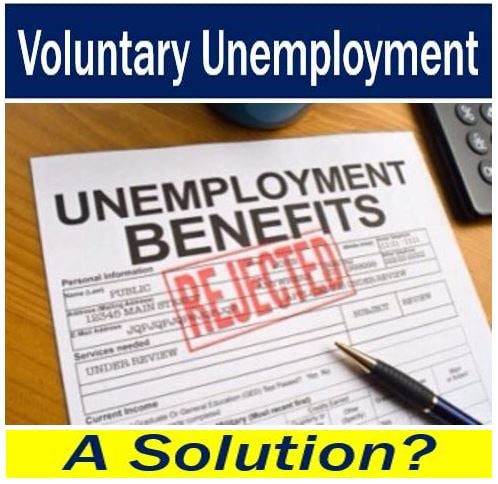Voluntary unemployment – definition and meaning
Voluntary unemployment means what it says; being unemployed not because you did not want to be jobless. However, the term can sometimes be misleading.
In most cases, it refers to the situation when a worker or employee deliberately chooses not to work for a variety of reasons – perhaps they were unhappy with the work conditions or wages of their previous job, or cannot currently find suitable employment.
When somebody wants to get another job, his or her main objective might not be to become unemployed. However, if they choose to leave their current position in order to have more time to search for a better one, they are in ‘voluntary unemployment’ during the ‘between jobs’ period. In this sense the term is misleading, because the person’s main aim is not to be willingly unemployed – it is to find another job.
Voluntary unemployment contrasts with involuntary unemployment, which includes people who are willing to work but are jobless.
In all cases of frictional unemployment, people are in a state of voluntary unemployment. Frictional unemployment refers to workers who are between jobs – they are still searching for their ideal position, going to interviews, filling and sending resumes (CVs), etc.
During full or near-full employment, frictional unemployment is higher, because people spend longer communicating with prospective employers and going to interviews – they take their time deciding whether what is being offered to them is what they really want.
In other words, voluntary unemployment is higher during periods of full or near-full employment.
During periods of high unemployment, frictional unemployment – and therefore voluntary unemployment – is lower, because people are less fussy and are more likely to grab whatever they can quickly.
Voluntary unemployment and welfare
The unemployment trap is a situation many unemployed people in the advance nations find themselves in. Because of their unemployment benefits – money and help provided by the state – they determine that they are better off financially by remaining out of work rather than taking a low-paying job.
 Would voluntary unemployment vanish if people who deliberately became or remained jobless lost their unemployment benefits? Some people believe it would, while others say it would not be a solution.
Would voluntary unemployment vanish if people who deliberately became or remained jobless lost their unemployment benefits? Some people believe it would, while others say it would not be a solution.
People who are stuck in the unemployment trap, also known as the welfare trap or poverty trap, are more likely to be unskilled, or have skills that are now obsolete, such as coalmining skills.
Voluntary unemployment includes people who are in the so-called unemployment trap.
The Financial Times’ dictionary of business and financial terms defines voluntary unemployment as follows:
“When people are unemployed and do not want to work and are not looking for a job, especially because they are satisfied with the money they are getting from the government in the form of unemployment benefit.”
Low wages and voluntary unemployment
Voluntary unemployment is more common when wages are low. Since the global financial crisis of 2007/8 and the Great Recession that followed, wages in the advanced economies, as well as most of the emerging economies, have barely managed to keep up with inflation.
A rising number of workers have been deciding to remain unemployed voluntarily. In most cases, because they are currently able to get by without working.
When wages start rising faster than inflation, voluntary unemployment numbers will probably decline.
Different types of unemployment
In an article published in Your Article Library, Smriti Chand writes that in today’s societies, there are nine main types of unemployment:
- Voluntary Unemployment: this type has been explained in this article.
- Frictional Unemployment: when a person is out of work while changing jobs.
- Casual Unemployment: occurs among workers who are employed on a day-to-day basis or very short-term contracts, as may occur in the building construction industry, as well as agriculture and catering.
- Seasonal Unemployment: in tourist resorts in the Mediterranean, for example, there are many more jobs during the summer months than during winter time. Seasonal unemployment is high during the off-seasons.
- Structural Unemployment: this type is not caused by the cyclical changes in the economic cycle – such as falling demand – but from changes within the structure of the economy itself. For example, automation forcing senior managers to lay off many workers in factories, warehouses, and other sectors of the economy.
- Technological Unemployment: this is a specific type of structural unemployment. People become unemployed when robots, new machinery, and other hi-tech devices and systems do the jobs that humans used to do.
- Cyclical Unemployment: unemployment levels rise when an economy goes into recession – demand falls, commpanies invest less, and workers are laid off. In modern free-market economies, recessions come in cycles.
- Chronic Unemployment: when high unemployment becomes a long-term feature of an economy. Many of the world’s poorest nations suffer from chronic unemployment or underemployment. ‘Chronic’ means ‘long term’.
- Disguised Unemployment: this type is difficult to measure. Imagine a tiny farm that is run by six members of a family. If three of them stopped working, production would not change. This means that there are three surplus workers there. Disguised unemployment refers to a situation of many workers are doing the job that fewer workers could do just as effectively.

